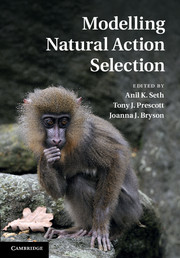Book contents
- Frontmatter
- Contents
- Foreword
- Preface
- Contributors
- 1 General introduction
- Part I Rational and optimal decision making
- Part II Computational neuroscience models
- Part III Action selection in social contexts
- 18 Introduction to Part III: action selection in social contexts
- 19 Agent-based models as scientific methodology: a case study analysing the DomWorld theory of primate social structure and female dominance
- 20 An agent-based model of group decision making in baboons
- 21 Endogenous birth and death of political parties in dynamic party competition
- 22 On optimal decision making in brains and social insect colonies
- 23 State-dependent foraging rules for social animals in selfish herds
- Index
- Plate section
- References
20 - An agent-based model of group decision making in baboons
from Part III - Action selection in social contexts
Published online by Cambridge University Press: 05 November 2011
- Frontmatter
- Contents
- Foreword
- Preface
- Contributors
- 1 General introduction
- Part I Rational and optimal decision making
- Part II Computational neuroscience models
- Part III Action selection in social contexts
- 18 Introduction to Part III: action selection in social contexts
- 19 Agent-based models as scientific methodology: a case study analysing the DomWorld theory of primate social structure and female dominance
- 20 An agent-based model of group decision making in baboons
- 21 Endogenous birth and death of political parties in dynamic party competition
- 22 On optimal decision making in brains and social insect colonies
- 23 State-dependent foraging rules for social animals in selfish herds
- Index
- Plate section
- References
Summary
Summary
We present an agent-based model of the key activities of a troop of chacma baboons (Papio hamadryas ursinus) based on data collected at De Hoop Nature Reserve in South Africa. The construction of the model identified some key elements that were missing from the field data that would need to be collected in subsequent fieldwork. We analyse the predictions of the model in terms of how well it is able to duplicate the observed activity patterns of the animals and the relationship between the parameters that control the agent's decision procedure and the model's predictions. At the current stage of model development, we are able to show that, across a wide range of decision parameter values, the baboons are able to achieve their energetic and social time requirements. The simulation results show that decisions concerning movement (group action selection) have the greatest influence on the outcomes. Group decision making is a fertile field for future research, and agent-based modelling offers considerable scope for understanding group action selection.
Introduction
Group living is a common strategy among mammals and is key to understanding the success of the primate order in general and early humans in particular. For animals that forage or move in social groups, decisions about when and where to move often depend upon social interactions between group members (Krause and Ruxton, 2002; Couzin et al., 2005). Little is actually known, however, about how groups of animals arrive at such collective decisions (Conradt and Roper, 2003). We focus on the problem of action selection in groups, i.e., where an individual's action choice is constrained by the choices of other members of the group.
- Type
- Chapter
- Information
- Modelling Natural Action Selection , pp. 454 - 476Publisher: Cambridge University PressPrint publication year: 2011

